History and Art and Culture
Context: Noted dancer Kanak Rele, who gave academic status to Mohiniyattam, passed away recently.
About Mohiniyattam:

- It originated in the state of
- The dance is performed by women in honor of the Hindu god Vishnuin his incarnation as the enchantress Mohini.
- Mohiniyattamis characterized by graceful, swaying body movements with no abrupt jerks or sudden leaps. It belongs to the Lasya style which is feminine, tender, and graceful.
- The references to Mohiniyattam can be found in the texts Vyavaharamala written in 1709 by Mazhamagalam Narayanan Namputiriand in Ghoshayatra, written later by poet Kunjan Nambiar.
- Mohiniyattam is exclusively danced by women.
The Classical dances recognized by the Government of India are:
- Bharatnatyam (Tamil Nadu)- Bharatanatyam has grown out of the art of dancers dedicated to temples, and was earlier known as Sadir or Dasi Attam.
- It is the first of India’s traditional dances to be refashioned as a theatre art.
- The musicians include at least one vocalist, a Mridangam (drum)-player, and a flutist or violinist or Veena (lute)-player.
- Kathak (North India)- It is the principal dance of northern India, and is widely practiced in Uttar Pradesh, Rajasthan, Delhi, Madhya Pradesh, and even parts of western and eastern India.
- It is believed to be connected with the narrative art of Kathakaras or story-tellers.
- The music of traditional Kathak consists of the Thumri and other lyrical song-forms, and the essential musical instruments are the Tabla, Pakhawaj, and Sarangi.
- Kathakali (Kerala)- Kathakali or ‘story play’ took shape in Kerala in southern India in the seventeenth century under the patronage of the prince of Karnataka, who wrote plays for performance drawn from the epic Ramayana in Malayalam.
- Kathakali categorizes its characters according to their nature and employs make-up and costume to build them up as symbolic personalities.
- Kuchipudi (Andhra Pradesh)- It originated from Andhra Pradesh, where it grew largely as a product of Bhakti movement beginning in the 7th Century AD and derives its name from the village Kuchelapuram.
- Kuchipudi today is performed either as a solo, duet or a group presentation, but historically it was performed as a dance drama, with several dancers taking different roles.
- Odissi (Odisha)- It was performed as part of temple service by ‘meharis’ or female temple servants.
- The traditional dance was remodeled as a theatre art towards the middle of the twentieth century.
- The dancer is supported by a singer, a drummer who plays the Pakhawaj, flute and Sitar.
- Sattriya (Assam)- ‘Sattriya dance’ refers to the body of dance and danced drama developed in the sattras or monasteries of Assam since the sixteenth century, when the Vaishnava faith propagated by the saint and reformer Shankaradeva (1449-1586).
- Group dances are also common in traditional and modern Sattriya dance, and these may be prefaced with a brief musical ‘interlude’ on drums, the Gayan Bayan.
- Manipuri (Manipur)- It evolved in Manipur, is anchored in the Vaishnava faith of the Manipur valley.
- Manipuri dance is introverted and restrained compared to most other dances of India – the artist never establishes eye contact with the audience.
- The Pung, a drum, and flute are the principal instruments used in Manipuri dance.
Source: THE INDIAN EXPRESS
Previous Year Questions
Q.1) With reference to Manipuri Sankirtana, consider the following statements: (2017)
- It is a song and dance performance
- Cymbals are the only musical instruments used in the performance
- It is performed to narrate the life and deeds of Lord Krishna
Which of the statements given above is/are correct?
- 1, 2 and 3
- 1 and 3 only
- 2 and 3 only
- 1 only
Q.2) With reference to the famous Sattriya dance, consider the following statements: (2014)
- Sattriya is a combination of music, dance and drama
- It is a centuries-old living tradition of Vaishnavites of Assam
- It is based on classical Ragas and Talas of devotional songs composed by Tulsidas, Kabir and Mirabai
Which of the statements given above is/are correct?
- 1 only
- 1 and 2 only
- 2 and 3 only
- 1, 2 and 3













